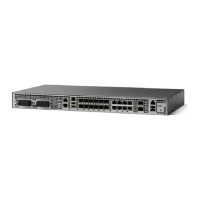PurposeCommand or Action
Enters global configuration mode.configure terminal
Example:
Router# configure terminal
Step 2
Specifies the interface and enters interface configuration
mode.
interface type/num
Example:
Router(config)# interface gigabitethernet 1/0
Step 3
Specifies that there is no IP address assigned to the
interface.
no ip address
Example:
Router(config-if)# no ip address
Step 4
Enables the autonegotiation protocol to configure the
speed, duplex, and automatic flow control of the Gigabit
Ethernet interface.
negotiation auto
Example:
Router(config-if)# negotiation auto
Step 5
Configures an Ethernet service instance.
service instance id service-type
Example:
Router(config)# service instance 1 ethernet
Step 6
Enables IEEE 802.1Q encapsulation of traffic on a
specified subinterface in a VLAN.
encapsulation dot1q vlan-id second-dot1q {any | vlan-id |
vlan-id-vlan-id[,vlan-id-vlan-id]}
Example:
Router(config-if)# encapsulation dot1q 2
Step 7
Places the interface in the same bridge domain as the
VFI interface.
bridge-domain vlan-id [access | dot1q [tag] | dot1q-tunnel]
[broadcast] [ignore-bpdu-pid] [pvst-tlvCE-vlan]
[increment] [lan-fcs] [split-horizon]
Step 8
Example:
Router(config-if)# bridge-domain 1000
Exits interface configuration mode.exit
Example:
Router(config-if)# exit
Step 9
Configuring the VFI in the PE
The virtual switch instance (VFI) specifies the VPN ID of a VPLS domain, the addresses of other PE routers
in this domain, and the type of tunnel signaling and encapsulation mechanism for each peer. (This is where
you create the VSI and associated VCs.) Configure a VFI as follows:
MPLS Basic Configuration Guide, Cisco IOS XE Everest 16.5.1 (Cisco ASR 900 Series)
118
VPLS Configuration over MPLS-TP
Configuring the VFI in the PE

